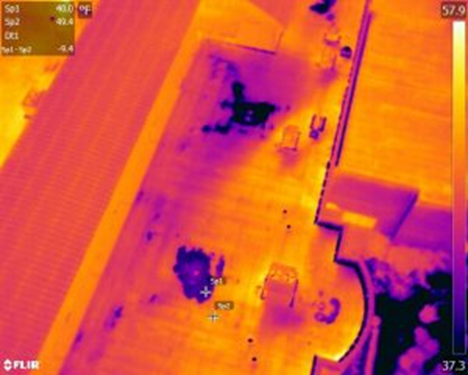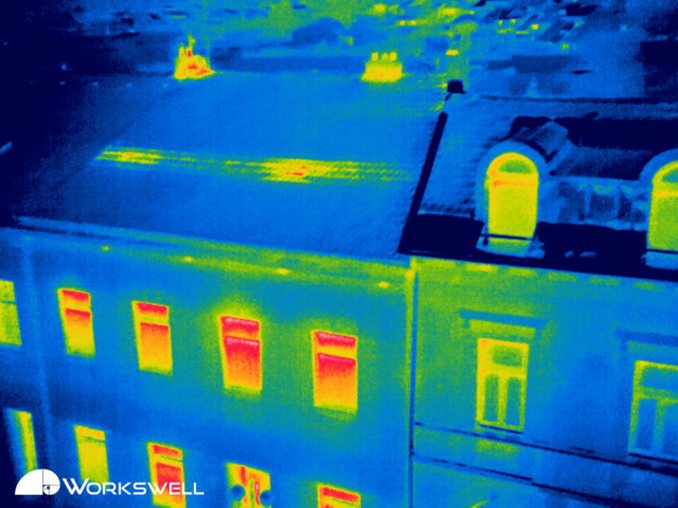1.Aerial Thermography and Energy Saving
The research found that the greatest Energy consumption sectors are the building sector, transport and industry, a survey done in Europe over a period from 1990 to 2008 found that the consumption in the building sector increased by an annual average of 0.7%. In the EU-27 industrial sector the energy consumption decreased by an annual average of 1.9%. The transport sector improved energy efficiency by an averaging 0.9% per year
Carbon dioxide price increased from the beginning of the year 2013 by 40%, to about 6.9 Euro per tonne, in order to reduce the emission of GHG greenhouse gases.
{A price on carbon helps shift the burden for the damage back to those who are responsible for it, and who can reduce it. Instead of dictating who should reduce emissions where and how, the price for carbon gives an economic signal and polluters decide themselves whether to reduce emissions, discontinue their polluting activity, or continue polluting and pay for it}.
However, this increase of emission prices will inevitably backlash by an estimated 50% increase of the energy prices.
As a result, saving energy is the cleanest way of reducing gas emissions. Its potentials are huge and much bigger than the possibility of alternative sources of energy, including renewable energy sources.
A very important, if not the most important issue for the countries at the stage of catching up with the most developed economies, is the fact that improving energy efficiency is the cheapest and most cost-effective way to achieve sustainable energy development
As shown in the above, the building is the sector that struggle the most to decrease the energy consumption because of the occurring heat loss from the interior of the buildings.
It is estimated that typical heat losses from a building are as follow:
• Walls – 35%;
• Roofs – 25%;
• Floors – 15%;
• Draughts – 15%;
• Windows – 10%.
As the buildings are typically large constructions, it is very convenient to perform thermal imaging inspections and keeping the proper distance from the object. A perfect solution is the usage of remotely operated unmanned aerial Vehicles (UAVs) equipped with IR cameras. An advantage of this solution also gives a possibility to inspect roof or other tall constructions that cannot be easily accessed by a man.
Most importantly is the UAV ability to take pictures for small, difficult areas, relatively no time and space constraints, low operating costs resulting in getting a view of a wide area in a minimum time and cost, an ability to support digital processing of aerial and satellite images, environmentally friendly application, and a relative independence from aviation weather conditions.

2. Industrial assets and buildings thermal surveying
 The persistent growth of energy prices and the stringent environmental regulation has created a need for buildings with enhanced heat insulation. Thermography is the ideal way to identify defects that reduce the efficacy of insulation, such as thermal bridges.
The persistent growth of energy prices and the stringent environmental regulation has created a need for buildings with enhanced heat insulation. Thermography is the ideal way to identify defects that reduce the efficacy of insulation, such as thermal bridges.

Thermographic inspections uncover errors and produce professional measurements to precisely localize defects.
In addition, it can be used for large-scale airborne temperature mapping to document temperature signatures on the scale of whole suburbs at once. Compared to the traditional hand held approach, the aerial data acquisition methods is the timely, versatile and inclusive detailed IR imagery in a wide geospatial data.
The applications of thermography in civil engineering include the identification of heat losses or water leakages in buildings. For instance, cooling down thermography can help in identifying subsurface structural deficiencies, and able to identify delamination in a concrete bridge structure.
Furthermore, it is possible to investigate the internal structure of a masonry bridge. Experimental evidence suggests that some sub-surface cracks are not detectable to the naked eye and thermographic analysis can better represent the baselines of the damages produced.
In this way, the thermography serves a range of applications from identifying heat losses up to the non-destructive testing of structures.
Roof inspection as another major service catches minor penetrations before they have a chance to escalate into costly repairs. UAV inspections can significantly reduce the time and expense of commercial roof inspections when compared to conventional methods.
Any trapped moisture under the roofing membrane will heat up during the daytime heating of the roof’s surface also called solar loading. After the sun sets, the roof’s surface will begin to cool, but the trapped moisture will maintain its warmth making it easily detectable using aerial thermal imaging. These areas of moisture are then documented for further investigation and proper repair recommendations.
Contact: NICOLE
Phone: +8613809686114
Tel: +8613809686114
Email: enquiry@keemal.com
Add: 3rd and 4th floors, Building 11, East District, Foreign High end Talent Cluster Zone, Shaoxing City, Zhejiang Province